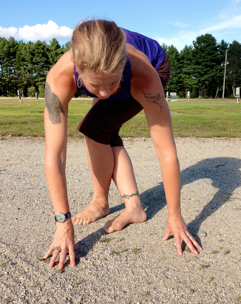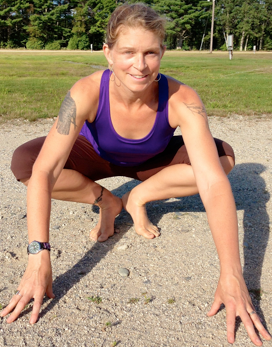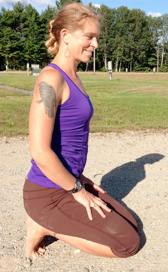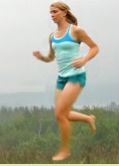Stretching won’t do much for your speed, and flexibility alone won’t make you less prone to injury but that doesn’t mean you should never stretch. While it’s true that a perfectly aligned human body moving in a natural environment should be able to maintain good muscular balance without any additive stretch or strength exercises, few of us have that privilege. Our squared-off, hard-surfaced, chair-filled modern environment confines our range of movement in ways we might not even notice until we start to try to move in other ways. Like running.
I have been practicing and teaching yoga for over 20 years and I’ve found it to be an outstanding way to help athletes improve their mobility, agility, strength and balance. Yoga combines stretch and strength to expand your functional range of motion and re-establish neutral alignment from head to toe.
Before I tell you about my favorite running stretches, I need to disabuse you of the most common yoga myth: Every athlete I meet tells me “I can’t do yoga! I can’t even touch my toes!” Not that it matters, but you can touch your toes. You might need to bend your knees and untuck your tail, but I guarantee your toes are within reach. Now, more importantly, should you be able to touch your toes?
Many years ago I got to debate this subject with my graduate school professor, Bernd Heinrich who happens to be both a phenomenal ultrarunner, talented field biologist, and author of “Why We Run.” I was studying winter ecology with him and we would spend all day literally running through the woods chasing down tiny little birds to see where they roosted at night. In between sprints he would climb to the top of huge spruce trees, drag cow carcasses uphill to our study site, crouch under a tree for an hour or more to watch the birds and then jog home for a hot meal and bed. After dinner I would roll out my yoga mat and attempt to recover from the day. One night as Bernd headed off to bed, he said “You know, the only time I’ve been injured running is when I tried stretching.”
And I agree. Athletes should be wary of stretching. Just plain old stretching (the kind that involves static or passive sagging into the joints) can cause ligament instability, joint injury and inhibit efficient muscular contraction. The thing is, I don’t practice this kind of stretching. For me, yoga is about muscular engagement, core strength and functional range of motion, not flexibility. In other words, I don’t care if you can’t touch your toes, and I won’t make you!
Like many of you, I was not raised running, crawling or climbing through the woods. I was raised sitting in chairs, walking on sidewalks and running on flat, paved playgrounds. On top of that I have profound hip dysplasia and scoliosis. There was nothing neutral about my posture when I started running. Of course I didn’t know that until the injuries began. Which is how I ended up in my first yoga class. Thankfully it was not the passive-stretching form of yoga that my physical therapist at the time was hoping for. Instead it was a strong, strength building style that has added years to the life of my hips and taught me profound body awareness. I use my yoga practice to keep my muscles balanced and my alignment neutral and I now happily run 50-70 miles a week, injury free.
The following stretches are my favorite post-run exercises. Pre-run your muscles are likely cold and tight. Stretching pre-run will tend to put too much strain on your connective tissues and joints, and if you do manage to effectively stretch the belly of your muscles pre-run, you aren’t doing yourself any favors as you are likely lowering their contractive efficiency. (http://www.unboundmedicine.com/medline/citation/22316148/abstract/Does_pre_exercise_static_stretching_inhibit_maximal_muscular_performance_A_meta_analytical_review_)
The purpose of the following poses is to dynamically stretch (and thus relax) the stronger tighter muscles such as the hip flexors and pectorals so you can engage and strengthen your glutes, upper hamstrings, multifidus (low back), and triceps and latissimus dorsi.
You can safely perform these stretch-strength exercises several times a week. Do each pose for as long as you can maintain the “engage” portion of the stretch working up to a minute on each side. The whole routine takes about 10 minutes and it’s okay to pick and choose your favorites.
1) Lazy pigeon

Why: Running tightens the piriformis muscle (the “pain in the butt” muscle). A tight piriformis can restrict external hip rotation, and lead to excessive “tail tucking” which is the main cause of low back pain in runners.
How: Back yourself up to a wall or tree for balance, cross one ankle over your knee. Bend your standing leg. Stick your butt out as if your sit bones were taillights and they are shining straight back into the wall behind you. Don’t round your back or tuck your pelvis under.
Engage: Flex the crossed ankle as if you were standing on it (don’t sickle the ankle) and press it into your hand. Actively tone your inner thigh muscles and try to stretch them back behind you. Lift and tone your low belly.
2) Shin Cross
Why: Runners often have strong, tight outer thigh muscles and weaker inner thigh muscles. This imbalance leads to outer hip pain and inner knee pain. Regular stretching and rolling of the Ischial Tibial Band (ITB) is an important part of resolving this imbalance.

How: Cross one shin in front of the other. Try to line up your toes and get both feet down on the ground. The more you bend the back leg the easier this will be. Bend over to touch the ground, or if the ground is really far away, put your hands on a chair, bleacher or windowsill. To intensify the stretch and really target the ITB, walk your hands to the side – away from your front foot.
Engage: Reach your inner thighs back. Push your back shin into your front shin. Lift your belly up away from your thighs.
3) Squat
Why: Running on flat hard surfaces restricts ankle and foot flexibility. Keeping your feet and Achilles tendons flexible and strong is vital to good running form and can help ward off the much dreaded plantar fasciitis.

How: Start standing with your feet turned out. Bow forward by bending your knees out to the sides and sticking your butt out until your can touch the ground. Lowering your hips into your lowest possible (pain-free) squat. Reach forward with your arms to help you balance.
Engage: Stretch your inner heels toward the ground. Hug your knees into your upper arms.
4) Toe-breaker pose
Why: Tight, weak foot muscles are the main cause of plantar fasciitis. Keeping your toes strong and flexible is a key part of keeping your feet healthy.
How: Sit down with your feet tucked underneath you and your toes flexed. This can be pretty excruciatingly painful at first. You can lift your butt up off your heels for less intensity, or even lean forward and put some weight on your hands.

Engage: Isometrically flick your toes backwards. Draw the arch of your foot from the front of your heels back toward your shins (as if you were sucking it closer to the bone).
Over time you should be able to sit comfortably with your toes tucked under you and your pinkies touching down for several minutes at a time.
***
Charlotte Clews lives in Maine with her family, and started teaching yoga in 1998. She’s also an ultrarunner, field researcher, scientist (M.S. in botany), and former instructor with the National Outdoor Leadership School in Alaska and the Yukon. She hiked the entire Appalachian and Pacific Crest Trails alone, and in 2002, she walked 2,000 miles of the Continental Divide Trail with her future husband, Jerome. She consults as a natural healer, and offers a 21-Day Cleanse and Sugar Detox online course. For more information about the course, Charlotte’s background, and her passion for barefoot running, go here: http://yoga-runner.com


Charlotte thanks for the great contribution and for keeping it simple. I do the last pigeon while typing and reading emails . this one for me has helped. keep sending good advice to our readers. Mark
Thank you!
I have been doing #1 and #3, since your piece came out. Feel the benefits already. I have always enjoyed squatting, but your squat technique is different. Easier on my knees.
#4 is tough at this point, I am afraid my old knees may lock up. My toes are supple though(toe yoga).
As an aside, I can manage the poses with nose breathing!
Thanks!
Indy M.